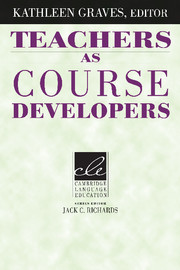Book contents
- Frontmatter
- Contents
- Contributors
- Series editor's preface
- Preface
- Acknowledgments
- 1 Teachers as course developers
- 2 A framework of course development processes
- 3 Designing workplace ESOL courses for Chinese health-care workers at a Boston nursing home
- 4 Designing a seventh-grade social studies course for ESL students at an international school
- 5 Designing an EAP course for postgraduate students in Ecuador
- 6 Designing a writing component for teen courses at a Brazilian language institute
- 7 Planning an advanced listening comprehension elective for Japanese college students
- 8 A curriculum framework for corporate language programs
- Further reading
- Index
4 - Designing a seventh-grade social studies course for ESL students at an international school
Published online by Cambridge University Press: 18 December 2009
- Frontmatter
- Contents
- Contributors
- Series editor's preface
- Preface
- Acknowledgments
- 1 Teachers as course developers
- 2 A framework of course development processes
- 3 Designing workplace ESOL courses for Chinese health-care workers at a Boston nursing home
- 4 Designing a seventh-grade social studies course for ESL students at an international school
- 5 Designing an EAP course for postgraduate students in Ecuador
- 6 Designing a writing component for teen courses at a Brazilian language institute
- 7 Planning an advanced listening comprehension elective for Japanese college students
- 8 A curriculum framework for corporate language programs
- Further reading
- Index
Summary
In addition to teaching transition classes for ESL students entering the academic mainstream. Pat Fisher, also teaches English literature and chairs the English Department at an international school in Japan where she has worked for more than a decade. Her department has been instrumental in curriculum development efforts at the school, having piloted different approaches and conducted workshops on the writing process and alternative assessment, such as portfolio use. In this chapter, she describes how she developed an ESL social studies course for seventh graders (middle school). Although the students' needs were clear to her, how to translate those needs into objectives and how to organize the objectives into meaningful, teachable categories constituted a challenge. Meeting the challenge involved hours of studying the objectives and content of ESL and mainstream textbooks and searching for a way to represent the organizing principles of her syllabus graphically. A pie chart proved to be the answer, and its development is described in this chapter.
The course development focus for this chapter is determining goals and objectives. Consider the following questions as you read:
What is the relationship between Fisher's overall goals and the specific objectives?
One of Fisher's main challenges was how to organize the objectives. What helped her to meet this challenge?
“The new ‘Freddy’ is awesome, man! It's really exciting!” Like all adolescents, my students were reluctant to give up their weekends to return to the classroom that morning.
- Type
- Chapter
- Information
- Teachers as Course Developers , pp. 63 - 85Publisher: Cambridge University PressPrint publication year: 1996

